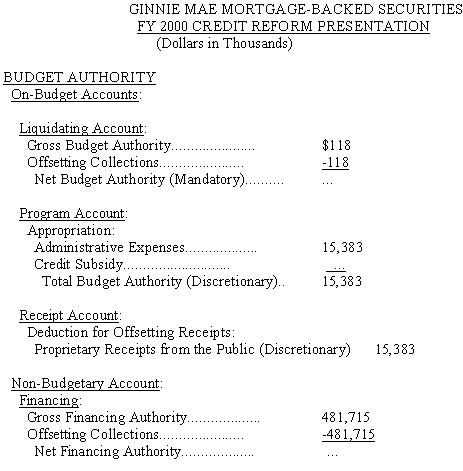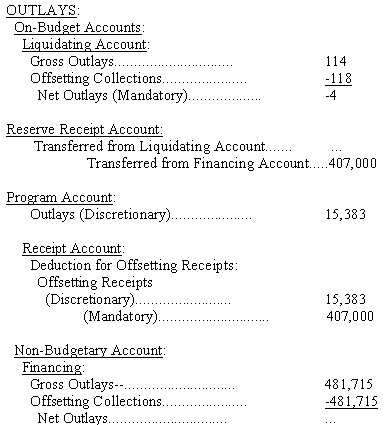 |
Home | En Español | Contact Us | A to Z |
 |
Guarentees of Mortgage-backed Securities
DEPARTMENT OF HOUSING AND URBAN DEVELOPMENT GOVERNMENT NATIONAL MORTGAGE ASSOCIATION GUARANTEES OF MORTGAGE-BACKED SECURITIES PROGRAM HIGHLIGHTS
SUMMARY OF BUDGET ESTIMATES
The Budget proposes a limitation on new commitments for single-class mortgage-backed securities (MBS) of $200 billion for fiscal year 2000. This request is based on FHA and VA estimates of mortgage insurance and guarantee activity. In addition, an appropriation of $15 million is proposed to fund administrative expenses; $9 million for salaries and expenses and $6 million to support development of a housing data warehouse to be used by FHA, VA and the Rural Housing Service (RHS). In fiscal year 2000, it is expected that $44.8 billion of Multiclass securities will be guaranteed. Since all Ginnie Mae guaranteed Multiclass securities will be based on and backed by mortgage-backed securities issued pursuant to commitment authority, separate commitment authority will not be required for the Multiclass securities. In fiscal year 2000, Ginnie Mae has estimated that $407 million in net receipts (not obligated to cover expenses) from the financing account be transferred to its reserve receipt account.
Ginnie Mae issued $130 billion of commitment authority in fiscal year 1998. Guarantees issued were $138.4 billion representing an increase of $40.8 billion over the $97.6 billion of guarantees issued in fiscal year 1997. The FHA and VA activity was stimulated by low interest rates during fiscal year 1998, causing a heavy volume of refinancing. During fiscal year 1998, Ginnie Mae experienced issuer defaults in the amount of $8.6 million. The total servicing portfolio balance as of September 30, 1998 is $627 million, a $200 million decrease from fiscal year 1997. The $8.6 million addition to the defaulted portfolio will more than offset the reduction resulting from the sale of servicing rights on the multifamily and single family portfolios, normal amortization, and other terminations of the outstanding loans. In fiscal year 1998, Ginnie Mae's single family servicing portfolio experienced defaults totaling $8.3 million. Additional single family defaults of $5 billion are anticipated for fiscal years 1999 through 2004. Future losses on the single family portfolio are expected to reach $199.6 million for fiscal years 1999 through 2004. In the multifamily program, there were no issuer defaults in fiscal year 1998. Defaults of $413 million are anticipated through 2004. Ginnie Mae will be fully indemnified by FHA on multifamily foreclosures except for administrative, assignment, and extraordinary costs. Losses from the multifamily portfolio are expected to reach $56.8 million for fiscal years 1999 through 2004. Ginnie Mae's manufactured housing servicing portfolio experienced a small issuer default totaling $300 thousand in fiscal year 1998. The end-of-year portfolio balance is $150 million, which is down $70 million from fiscal year 1997. Losses from the mobile home portfolio are expected to reach $254 million from fiscal years 1999 through 2004. Ginnie Mae has also placed a moratorium on new issuers coming into the manufactured housing underlying program until the program can be properly evaluated and restructured. Ginnie Mae's strategy with respect to the management of acquired servicing is to stabilize and ultimately sell the portfolio at market value. When Ginnie Mae defaults an issuer, it assumes the issuer's status and assigns subservicing of the acquired portfolio to a contract subservicer. With the assistance of the subservicers, Ginnie Mae manages the individual pools by improving collections on delinquent loans, filing claims with FHA and VA on defaulted mortgages and foreclosed properties, and modifying loans in manufactured housing pools. Where possible, the pools are then packaged for sale of the servicing rights of the portfolio.
FISCAL YEAR 1999 ESTIMATES
EXPLANATION OF INCREASES AND DECREASES Advances and default expenses in the fiscal year 1999 current estimate increased from the Budget estimate due to a slight decline in the projected sale of servicing rights in the single family portfolio. The guarantee fee estimate shows a slight decrease due to low interest rates causing high refinancing. The large positive outlays in the liquidating account is the result of the transfer of $5.5 billion (unobligated balance) into the reserve receipt account. This transaction involves the obligations and the net outlays. The decrease in net receipts in fiscal year 1999 current estimate is attributable to the transfer of $355 million in negative subsidy from the financing account to its Reserve Receipt Account. PROGRAM DESCRIPTION This program facilitates the financing of residential mortgage loans insured or guaranteed by the Federal Housing Administration (FHA), the Department of Veterans Affairs (VA) and the Rural Housing Service (RHS). Funds are provided through investments in long-term securities guaranteed by Ginnie Mae which are backed by pools of such mortgages. The investment proceeds are used in turn to finance additional mortgage loans. Institutions which originate and service mortgages (such as mortgage companies, commercial banks, savings banks, and savings and loan associations) assemble pools of mortgages and issue securities backed by the pools. Investors in Ginnie Mae securities include mortgage investors, pension and retirement funds, life insurance companies and individuals. Ginnie Mae currently guarantees modified "pass-through" type securities. Modified pass-through securities provide payment to registered holders of interest plus the monthly installments of principal due on the pooled mortgages, whether or not collected, plus any additional principal collections. Separate pass-through programs have been developed to finance single family homes, multifamily projects and manufactured housing. Ginnie Mae first issues a "commitment" to the prospective securities issuer indicating that the firm meets Ginnie Mae's eligibility requirements. After Ginnie Mae issues the commitment, the issuer can begin to assemble mortgage pools and issue securities. Securities are issued with minimum face amounts of $25,000 and increments of $5,000 thereafter which have the same aggregate face amount as the aggregate unpaid balance of the pooled mortgages and bear interest at the rate borne by the mortgages--less the amount of issuer servicing fees and Ginnie Mae guarantee fees. Ginnie Mae's credit risk in this program is limited by mortgage insurance provided by Government agencies with respect to all pooled loans. Ginnie Mae's Multiclass securities program guarantees Real Estate Mortgage Investment Conduit (REMIC) and Ginnie Mae Platinum securities. A REMIC security is backed by a pool or trust composed of mortgages or mortgage-backed securities (MBS). The REMIC issuer issues certificates of interest to investors and elects to be taxed under the REMIC provisions of Federal tax law (Sections 860A through 860G of the Internal Revenue Code of 1986). REMICs are multiple class securities with different maturities, typically between 2 and 20 years, or with payments based on fractions of the MBS income stream. This multiple class characteristic is what largely distinguishes REMICs from single class Mortgage-Backed Securities of the kind that Ginnie Mae has been guaranteeing since 1970. The Ginnie Mae Platinum security consolidates Ginnie Mae MBS pools with the same interest rate into larger pools which are sold to investors by securities dealers. Ginnie Mae, under its Multiclass securities program, will guarantee only securities based on and backed by mortgage-backed securities guaranteed by Ginnie Mae. Since all Ginnie Mae guaranteed Multiclass securities will be based on and backed by MBS issued pursuant to previously issued commitment authority, additional commitment authority will not be required for the Multiclass securities. Ginnie Mae started the Targeted Lending Initiative on October 1, 1996. The targeted lending initiative was developed by Ginnie Mae in support of its statutory purpose and the national homeownership strategy announced by the President and the Secretary. It is consistent with Ginnie Mae's statutory purpose to promote access to mortgage credit in the central cities by increasing the liquidity of mortgage investments and improving the distribution of investment capital available for residential mortgage financing. Through the Targeted Lending Initiatives, Ginnie Mae reduces the guarantee fees it charges lenders by up to 50 percent for making mortgage loans in any of the Nation's 72 Empowerment Zones or Enterprise Communities and adjacent eligible central city areas. The incentive to lenders has financed over $5 billion in central cities.
PROGRAM ACTIVITY
The changes in the outstanding principal balance of securities for fiscal years 1998, 1999, and 2000 are shown in the following table:
The Multiclass Program began in 1995. Estimated program activity, which involves a Ginnie Mae-guarantee on the Multiclass securities that are backed by already Ginnie Mae-guaranteed securities, is shown in the following table:
Expenses reflect cost of operations including a write-down of assets held in inventory (real estate-owned properties, manufactured housing units, mortgages, and claims receivable) to the lower of cost or market value. During fiscal year 1998, $41.6 million was written-down. The following table reflects the composition of program net income:
Sale of Servicing Rights In fiscal year 1998, there were no sales of servicing rights. Sales proceeds from the sale of servicing rights in fiscal years 1999 and 2000 are estimated to be $258 thousand and $266 thousand, respectively. Fiscal year 2000 Performance Indicators Ginnie Mae expects to achieve the following objectives in 2000:
Indicator: Maintain and/or increase liquidity of funds available for FHA- and VA-backed mortgages, thereby lowering mortgage rates for home buyers using Federal credit.
Benchmark: Maintain or increase percentage of FHA, VA and Rural Housing Service securitization; introduce new products and/or innovations, implement efficiencies that result in cost savings.
Indicator: Maintain 95 percent rate of securitizing FHA and VA single-family mortgages annually.
Indicator: Increase the share of FHA multifamily mortgages securitized by 10 percent.
Indicator: Increase revenue from multiclass security credit enhancement.
Benchmark: Increase volume to the multiclass security program by 10 percent. 2. Enable the Ginnie Mae Mortgage-Backed Securities Program to be self-supporting. Indicator: Maintain adequate reserve fund based on estimates derived from Ginnie Mae's Policy and Financial Analysis Model. FEDERAL CREDIT REFORM
The Omnibus Budget Reconciliation Act (OBRA--P.L. 101-508) required Federal credit programs to implement credit reform beginning in fiscal year 1992. This year's Budget presentation for Ginnie Mae has been structured with four accounts to comply with the requirements of OBRA. In fiscal year 2000, the Financing Account will outlay $422 million from its net receipts to a Receipt Account from which $9 million will be appropriated for administrative expenses into the Program Account, $6 million for the development of a data warehouse under the direction of the Federal Housing Consortium and $407 million from its net receipts to the Reserve Receipt Account for negative subsidy. The Financing Account is treated as a non-budgetary account. Budget authority and outlay data, for each of the new accounts, is presented in the following table.
|
||
| Content Archived: January 20, 2009 | ||










